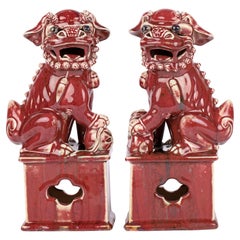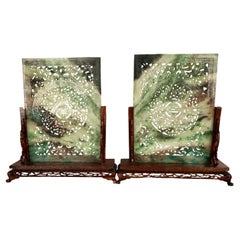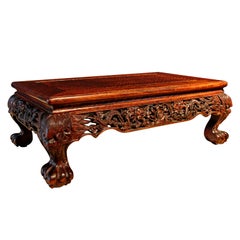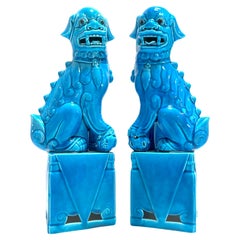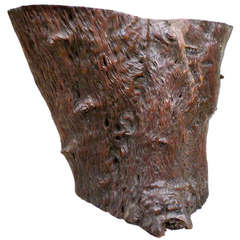1850s Scholar's Objects
to
1
1
2
53
171
254
23
85
42
48
12
3
2
1
1
3
4
5
21
3
1
1
1
1
1
2
2
2
2
2
2
Period: 1850s
Chinese Qing Pair Jun-Ware Liver Red Glazed Foo Dogs
Located in Bishop's Stortford, Hertfordshire
A rare and attractive pair Chinese Qing Jun-ware Foo dogs decorated in liver red glazes and dating from around 1850. The porcelain dogs are heavily made and stand raised on rectangul...
Category
Chinese Qing Antique 1850s Scholar's Objects
Materials
Porcelain
19th C Pair Antique Chinese Qing Carved Jade Scholar's Table Screens Stands 1850
Located in Portland, OR
A fine pair of antique Chinese Qing dynasty ( 1644-1911) hand carved jade table screens, circa 1850.
The rectangular screens are made of variegated s...
Category
Chinese Qing Antique 1850s Scholar's Objects
Materials
Jade
Related Items
Chinese Carved Longyan Wood Stand, Late Qing Dynasty
Located in Austin, TX
An exquisite late Qing dynasty display Stand of longyan wood, carved as a miniature "kang" table.
The center panel features an amazing grain that delights the eye, while a soft glo...
Category
Chinese Qing Antique 1850s Scholar's Objects
Materials
Fruitwood
Large Pair of Chinese Export Turquoise Foo Dogs
Located in West Palm Beach, FL
A Large Pair of Chinese Export Turquoise Foo Dogs
China, 20th century
This impressive pair of Chinese export porcelain foo dogs, made in the 20th century, highlights exquisite cra...
Category
Chinese Chinese Export 1850s Scholar's Objects
Materials
Porcelain
$736 Sale Price / set
20% Off
H 12.75 in W 5 in D 2.5 in
Pair of Mid-Century Chinese Ceramic Polychrome Foo Dogs
Located in San Diego, CA
Great pair of mid-century polychrome glazed ceramic foo dogs from China, circa 1950s. Great detail with each dog holding a coin medallion in its mouth and a beautiful color combinati...
Category
Chinese Mid-Century Modern 1850s Scholar's Objects
Materials
Ceramic
Chinese Cloisonne Incense Tool Vase, Qing Dynasty, 18th/19th Century, China
Located in Austin, TX
A small and elegant Chinese cloisonné vase for incense tools, Qing Dynasty, 18th/19th century, China.
Made for the scholar's studio, this small refined vase, was used to hold incense tools, including a small pair of tongs or chopsticks and spoon. The tools no longer present.
Of miniature baluster vase form, the vase beautify proportioned and decorated in the cloisonné enamel technique, with gilt wires forming the cloisons, or partitions. Within the cloisons, colorful enamels have been expertly laid.
The small incense tool vase...
Category
Chinese Qing Antique 1850s Scholar's Objects
Materials
Copper, Enamel
$6,800
H 3.75 in Dm 1.75 in
Pair of Qing Dynasty Foo Dog Lions, China circa 1950
Located in New York, NY
Pair of charming polychrome ceramic Foo Dog / Lions in the Qing Style. Fantastic detail and a beautiful color combination of ochre, green, brown and blue. Foo dogs are symbolic, pro...
Category
Chinese Qing 1850s Scholar's Objects
Materials
Ceramic
Large Pair of Chinese Export Sancai Glazed Foo Dogs
Located in West Palm Beach, FL
Large Pair of Chinese Export Sancai Glazed Foo Dogs
China, 20th Century
An exquisite, large-scale Sancai glazed pair of Foo Dogs, featuring elaborately decorated Foo Dogs with rema...
Category
Chinese Chinese Export 1850s Scholar's Objects
Materials
Pottery
$3,116 Sale Price / set
20% Off
H 16 in W 8 in D 15 in
pair of Chinese turquoise glazed porcelain foo lions/dogs
Located in New York, NY
a female and a male foo lion/dog
Category
Chinese 1850s Scholar's Objects
Materials
Porcelain
Pair Of Chinese Glazed Ceramic Foo Dogs
Located in Houston, TX
Pair Of Chinese Glazed Ceramic Foo Dogs.
This unusual pair of Chinese export glazed ceramic foo dogs are of cream and black
color with illegible...
Category
Chinese Chinese Export 1850s Scholar's Objects
Materials
Ceramic
Antique Japanese Shino Ware Chawan Tea Bowl
Located in Atlanta, GA
On offer is a Japanese ceramic tea bowl (chawan) used in the traditional chado ceremony. The bowl was potted in clog form with a ring foot shaved extremely low. Its size and harmonious proportion make it perfect to be held in both hands during chado. Classified as shino ware...
Category
Japanese Edo Antique 1850s Scholar's Objects
Materials
Ceramic
Pair Chinese White Glazed Guanyin, Qing Dynasty, 18th Century, China
Located in Austin, TX
A sublime and rare pair of Chinese white glazed porcelain figures of Guanyin, attributed to Tang Ying (1682 - 1756), Qing Dynasty, Qianlong Period, China.
This ethereal pair of white glazed porcelain figures depict the revered Buddhist Goddess of Mercy, Guanyin. Guanyin is portrayed standing, wearing heavy robes that drape beautifully around her figure. Bare feet peek out from under the hem of the robes. Her hair piled in a high chignon and covered by a cowl. The treatment of the hair, finely textured, unglazed, and with remnants of darker pigment, is typical of works by Tang Yin (1682 - 1756), who was the head of the imperial porcelain works at Jingdezhen.
Guanyin's beatific face is set in a serene smile, with a small, flat nose, and downcast, heavily lidded, almond shaped eyes. A simple beaded necklace graces her chest. Her hands held out, and may have once held attributes.
The hands were originally removable, but have since been permanently attached.
The figures crafted of a fine porcelain and glazed all over in a supple white glaze.
One figure bears a label from the Rafi Mottahedeh collection to the back.
Provenance:
Chinese Porcelain Company...
Category
Chinese Qing Antique 1850s Scholar's Objects
Materials
Porcelain
$21,000 / set
H 13.25 in W 5 in D 4 in
Pair of Chinese Porcelain Foo Dogs
Located in Essex, MA
Each seated on pedestals one stepping on a ball the other clutching a reptilian creature. Painted in the spinach and egg color.
Category
Chinese Antique 1850s Scholar's Objects
Materials
Other
Pair Of Chinese Turquoise Glazed Porcelain Foo Dogs
Located in Houston, TX
Pair Of Chinese Turquoise Glazed Porcelain Foo Dogs.
A large pair of Chinese turquoise glazed foo dogs dating from the first half of the 20th c...
Category
Chinese Chinese Export Vintage 1850s Scholar's Objects
Materials
Porcelain
Previously Available Items
19th Century Large Chinese Scholar's Wood Brush Pot
Located in Torino, IT
A 19th century large Chinese scholar's wood brush pot.
Category
Chinese Antique 1850s Scholar's Objects
Recently Viewed
View AllMore Ways To Browse
Glass Overlay Chinese Snuff Bottle
Lingbi Scholar Stones
Chinese Bone Horse
Jade Scholar Stone
Antique Bamboo Brush Pots
Antique Chinese Brush Holder
Taihu Stone
Qing Ink Stone
Vintage Paint Brush Horse Hair
Carved Bone Horses
Antique Chinese Carved Bamboo Brush Pot
Antique Chinese Snuff Bottles Inside Painted
Jade Archer
Calligraphy Brush Stand
Jade Archer Ring
Bamboo Brush Holder
Chinese Calligraphy Brush And Stand
Chinese Wood Carvings Bamboo Brush Pots
